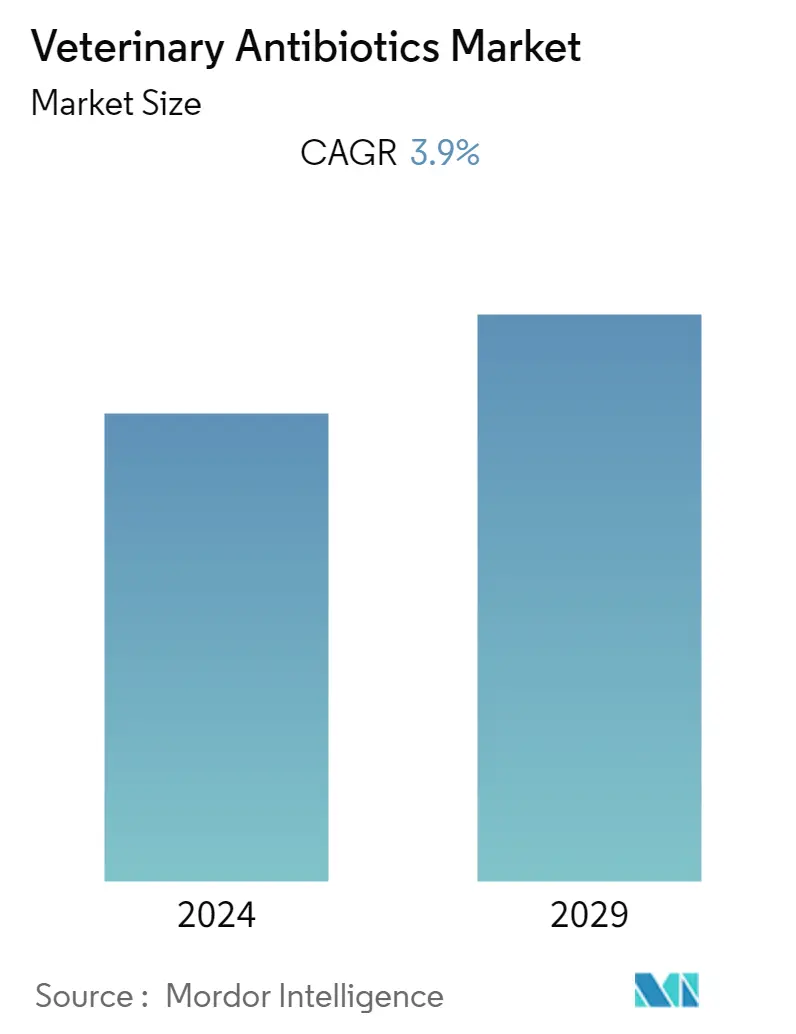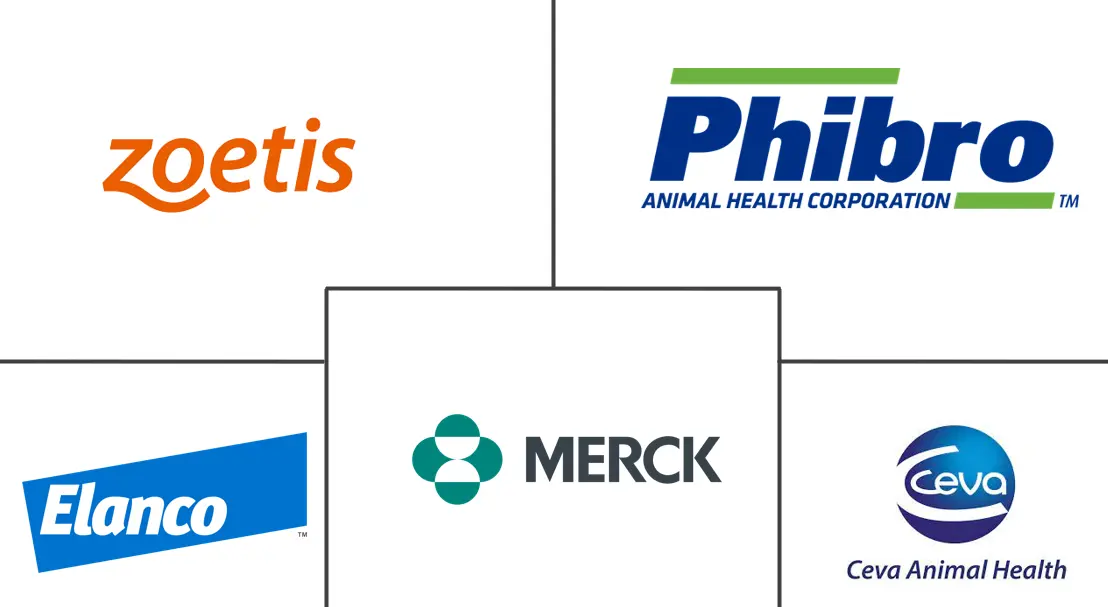Market Size of Veterinary Antibiotics Industry

| Study Period | 2019 - 2029 |
| Base Year For Estimation | 2023 |
| CAGR | 3.90 % |
| Fastest Growing Market | Asia-Pacific |
| Largest Market | North America |
| Market Concentration | Medium |
Major Players
*Disclaimer: Major Players sorted in no particular order |
Veterinary Antibiotics Market Analysis
The veterinary antibiotics market is expected to register a CAGR of 3.9% over the forecast period.
The demand for veterinary antibiotics was severely hampered due to the significant impact on veterinary practice during the lockdown period. The diagnosis rate of veterinary infection declined during the initial phase of the COVID-19 pandemic. The strict lockdown imposed in the majority of the countries was responsible for the negative impact on the veterinary practice along with the decline in demand for veterinary drugs including veterinary antibiotics. According to the study published by the British Veterinary Association, in May 2022, 32.8% of pet owners recorded difficulties in accessing veterinary healthcare during the initial phase of the COVID-19 lockdown. Veterinary healthcare facilities were open for emergency procedures however most of the prophylactic treatments were delayed for the animals.
Moreover, the disruption in the supply chain of veterinary pharmaceutical products, along with the reallocation of veterinarians for the management of COVID-19 had a significant impact on veterinary treatment which significantly hampered the market growth. Due to the above-mentioned factors, the majority of veterinary pharmaceutical companies recorded a significant decline in product sales during the COVID-19 pandemic.
Furthermore, the increasing number of animal health concerns along with the growing awareness about veterinary diseases is anticipated to drive the adoption of veterinary antibiotics during the forecast period. The growing number of livestock in developing as well as developed countries are also supporting market growth. According to the data published by, Eurostat (European Union), there were more than 142 million pigs, 76 million bovine animals, 60 million sheep, and 11 million goats in European countries by the end of December 2021.
Moreover, the large number of pet owners and rising expenditure on animal health are also driving the demand for animal medicines including veterinary antibiotics. According to the data published by HealthforAnimals, the population of pets in European nations is more than 215 million pet owners as compared to China which had more than 131 million pet owners in 2021. Furthermore, the increasing number of veterinary insurance holders is also anticipated to drive the market for various animal medicines including veterinary antibiotics.
However, stringent regulations and increasing antibiotic resistance among food-producing animals, along with the scarcity of veterinarians and skilled farm workers hinder the market growth.
Veterinary Antibiotics Industry Segmentation
As per the scope of the report, veterinary antibiotics are primarily used to treat infectious diseases as well as preventative treatment for livestock and companion animals. The veterinary antibiotics market is segmented by Animal Type (Poultry, Pigs, Cattle, Sheep & Goats, Companion Animals, and Other Animal Types), Drug Class (Tetracyclines, Penicillin, Sulfonamides, Macrolides, and Other Drug Classes), Dosage Form (Oral Powder, Oral Solutions, Injections, and Other Dosage Forms), and Geography (North America, Europe, Asia-Pacific, Middle East, and Africa, and South America). The market report also covers the estimated market sizes and trends for 17 different countries across major regions, globally. The report offers the value (in USD million) for the above segments.
| By Animal Type | |
| Poultry | |
| Pigs | |
| Cattle | |
| Sheep & Goats | |
| Companion Animals | |
| Other Animal Types |
| By Drug Class | |
| Tetracyclines | |
| Penicillin | |
| Sulfonamides | |
| Macrolides | |
| Other Drug Classes |
| By Dosage Form | |
| Oral Powder | |
| Oral Solutions | |
| Injections | |
| Other Dosage Forms |
| Geography | ||||||||
| ||||||||
| ||||||||
| ||||||||
| ||||||||
|
Veterinary Antibiotics Market Size Summary
The veterinary antibiotics market is poised for steady growth over the forecast period, driven by increasing animal health concerns and awareness about veterinary diseases. The market experienced a downturn during the COVID-19 pandemic due to disruptions in veterinary practices and supply chains, which led to a decline in demand for veterinary drugs, including antibiotics. However, the growing livestock population in both developed and developing countries, along with a rise in pet ownership and expenditure on animal health, is expected to bolster market expansion. The market is also influenced by the increasing number of veterinary insurance holders, which is anticipated to further drive the demand for veterinary antibiotics. Despite these positive trends, the market faces challenges such as stringent regulations, antibiotic resistance, and a shortage of skilled veterinarians and farm workers.
Penicillin is expected to lead the market growth, supported by its widespread use in managing various infectious diseases among livestock and pets. The easy availability of penicillin products and the proactive initiatives by major players to optimize antibiotic use are contributing to this segment's expansion. North America is projected to dominate the market due to the rising number of livestock and companion animals, increased spending on animal health, and a growing number of veterinary clinics. The presence of key industry players and new product launches in the region are also significant factors driving market growth. The competitive landscape is moderately consolidated, with major companies like Boehringer Ingelheim, Zoetis, and Merck & Co. playing pivotal roles in shaping the market dynamics.
Veterinary Antibiotics Market Size - Table of Contents
-
1. MARKET DYNAMICS
-
1.1 Market Overview
-
1.2 Market Drivers
-
1.2.1 Growing Pet & Livestock Ownership
-
1.2.2 Increasing Incidence of Livestock Diseases
-
1.2.3 Rising Focus On Animal-Only Antibiotics
-
-
1.3 Market Restraints
-
1.3.1 Stringent Regulations and Increasing Antibiotic Resistance Among Food-Producing Animals
-
1.3.2 Scarcity of Veterinarians and Skilled Farm Workers
-
-
1.4 Porter's Five Force Analysis
-
1.4.1 Threat of New Entrants
-
1.4.2 Bargaining Power of Buyers/Consumers
-
1.4.3 Bargaining Power of Suppliers
-
1.4.4 Threat of Substitute Products
-
1.4.5 Intensity of Competitive Rivalry
-
-
-
2. MARKET SEGMENTATION (Market Size by Value - USD million)
-
2.1 By Animal Type
-
2.1.1 Poultry
-
2.1.2 Pigs
-
2.1.3 Cattle
-
2.1.4 Sheep & Goats
-
2.1.5 Companion Animals
-
2.1.6 Other Animal Types
-
-
2.2 By Drug Class
-
2.2.1 Tetracyclines
-
2.2.2 Penicillin
-
2.2.3 Sulfonamides
-
2.2.4 Macrolides
-
2.2.5 Other Drug Classes
-
-
2.3 By Dosage Form
-
2.3.1 Oral Powder
-
2.3.2 Oral Solutions
-
2.3.3 Injections
-
2.3.4 Other Dosage Forms
-
-
2.4 Geography
-
2.4.1 North America
-
2.4.1.1 United States
-
2.4.1.2 Canada
-
2.4.1.3 Mexico
-
-
2.4.2 Europe
-
2.4.2.1 Germany
-
2.4.2.2 United Kingdom
-
2.4.2.3 France
-
2.4.2.4 Italy
-
2.4.2.5 Spain
-
2.4.2.6 Rest of Europe
-
-
2.4.3 Asia-Pacific
-
2.4.3.1 China
-
2.4.3.2 Japan
-
2.4.3.3 India
-
2.4.3.4 Australia
-
2.4.3.5 South Korea
-
2.4.3.6 Rest of Asia-Pacific
-
-
2.4.4 Middle East and Africa
-
2.4.4.1 GCC
-
2.4.4.2 South Africa
-
2.4.4.3 Rest of Middle East and Africa
-
-
2.4.5 South America
-
2.4.5.1 Brazil
-
2.4.5.2 Argentina
-
2.4.5.3 Rest of South America
-
-
-
Veterinary Antibiotics Market Size FAQs
What is the current Veterinary Antibiotics Market size?
The Veterinary Antibiotics Market is projected to register a CAGR of 3.9% during the forecast period (2024-2029)
Who are the key players in Veterinary Antibiotics Market?
Zoetis Services LLC., Phibro Animal Health Corporation, Ceva, Merck & Co., Inc. and Elanco are the major companies operating in the Veterinary Antibiotics Market.

